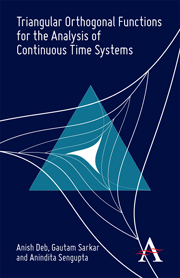Book contents
- Frontmatter
- Contents
- Preface
- Chapter 1 Walsh, Block Pulse, and Related Orthogonal Functions in Systems and Control
- Chapter 2 A Newly Proposed Triangular Function Set and Its Properties
- Chapter 3 Function Approximation via Triangular Function Sets and Operational Matrices in Triangular Function Domain
- Chapter 4 Analysis of Dynamic Systems via State Space Approach
- Chapter 5 Convolution Process in Triangular Function Domain and Its Use in SISO Control System Analysis
- Chapter 6 Identification of SISO Control Systems via State Space Approach
- Chapter 7 Solution of Integral Equations via Triangular Functions
- Chapter 8 Microprocessor Based Simulation of Control Systems Using Orthogonal Functions
- Index
Chapter 1 - Walsh, Block Pulse, and Related Orthogonal Functions in Systems and Control
Published online by Cambridge University Press: 05 June 2012
- Frontmatter
- Contents
- Preface
- Chapter 1 Walsh, Block Pulse, and Related Orthogonal Functions in Systems and Control
- Chapter 2 A Newly Proposed Triangular Function Set and Its Properties
- Chapter 3 Function Approximation via Triangular Function Sets and Operational Matrices in Triangular Function Domain
- Chapter 4 Analysis of Dynamic Systems via State Space Approach
- Chapter 5 Convolution Process in Triangular Function Domain and Its Use in SISO Control System Analysis
- Chapter 6 Identification of SISO Control Systems via State Space Approach
- Chapter 7 Solution of Integral Equations via Triangular Functions
- Chapter 8 Microprocessor Based Simulation of Control Systems Using Orthogonal Functions
- Index
Summary
Orthogonal properties [1] of familiar sine–cosine functions have been known for over two centuries; but the use of such functions to solve complex analytical problems was initiated by the work of the famous mathematician Baron Jean-Baptiste-Joseph Fourier [2]. Fourier introduced the idea that an arbitrary function, even the one defined by different equations in adjacent segments of its range, could nevertheless be represented by a single analytic expression. Although this idea encountered resistance at the time, it proved to be central to many later developments in mathematics, science, and engineering.
In many areas of electrical engineering the basis for any analysis is a system of sine–cosine functions. This is mainly due to the desirable properties of frequency domain representation of a large class of functions encountered in engineering design. In the fields of circuit analysis, control theory, communication, and the analysis of stochastic problems, examples are found extensively where the completeness and orthogonal properties of such a system lead to attractive solutions. But with the application of digital techniques in these areas, awareness for other more general complete systems of orthogonal functions has developed. This “new” class of functions, though not possessing some of the desirable properties of sine–cosine functions, has other advantages to be useful in many applications in the context of digital technology. Many members of this class of orthogonal functions are piecewise constant binary valued, and therefore indicated their possible suitability in the analysis and synthesis of systems leading to piecewise constant solutions.
- Type
- Chapter
- Information
- Publisher: Anthem PressPrint publication year: 2011



